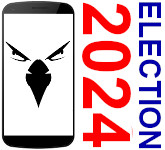Why the New York Times is getting outliers in Pennsylvania and Arizona
| Political Ref - Permalink
Nate Cohn expresses befuddlement at his polling results in Pennsylvania showing a four-point Harris lead at the same time they find a six-point Trump lead in Arizona, and rightly so. He offers the argument that perhaps pollsters should not weight for recall vote, admitting that Biden wins by ten in recall vote with their obviously overwhelming Democratic leaning sample showing Harris up by four. This means that Harris's 2024 poll lead trails Biden's 2020 poll lead over Trump by six points. Biden won by 1.17% in 2020. Lets see, ten minus four is six and six is greater than one, so that means Trump is up by five, right? Not according to the New York Times. Perhaps that margin hints at a likely conclusion on her chances?
Cohn suggests that the recall vote favors the loser in the previous elections because voters don't remember voting for the loser. While failing memory may hamper the recall vote tool with some elections, does it hurt recall vote this time? Maybe voters forget voting for a barely known congressional candidate, but do they forget voting for Trump? Trump faced two assassination attempts and draws the rageful ire of ninety percent of the media, pop culture, academia and the bureaucrat class. We forget insignificant people, not Trump. Recall vote still stands in this election. Pollsters should use it.
So the recall vote argument does not hold water with Trump, perhaps elsewhere, but not in this case. Lets consider the voter sample the NYT's pollster built. Looking at the likely voter sample in Pennsylvania, one would strain to argue that the sample includes the correct amount of white ID and the white ID it includes reflects accurate voter sentiment. The sample assumes a world that simply does not exist in the Keystone state.
This poll assumes Harris is virtually tied with white voters in PA and only trails men by five points. Pennsylvania will no doubt see white ID composing around an eighty percent share of the total vote. This poll assumes it only reaches sixty-nine percent. Such a radical assumption could represent the majority of the four-point Harris margin. As for reaching a tie with white voters, every poll in Pennsylvania disagrees with this finding. Yes, if that's true, she's ahead, but it's not true.
Why might the white voter sample suggest a tie? Perhaps a hidden Trump voter problem exists. I think this is a certainty based on the last two elections. I further think the problem is worse in Pennsylvania, a state that represents ground zero in the 2024 battle where one cannot use any media whatsoever without inundation with political warfare. I believe that has shaped voters' willingness to answer pollsters differently on both sides. When determining which side will more likely flee pollsters as a result of this inundation, simply ask yourself who has more tolerance for the drama. Is it a parent with kids who is working overtime to keep up or the single person who likely has much more free time? Voters with children lean heavily Trump and single people lean heavily Harris. There's your hidden Trump voter, exhausted people who don't have the time or the patience to answer a lengthy poll. This also demonstrates why Trafalgar gets better results for Trump, ease and convenience of taking the poll.
As for men, one cannot spend five minutes watching political coverage in America without seeing the sheer panic Democrats manifest at their inability to connect with men, but presumably just not in Pennsylvania. The male dominated Teamsters union convincingly voted to back Biden in the spring of this year only to overwhelming back Trump once Harris became the nominee. Might the Teamsters represent a fair depiction of male voter sentiment in Pennsylvania? Can you imagine her trailing Trump by only five with that crew? Of course not. To assume that Harris is nearly tied with men in an overwhelmingly white ID state requires blinders.
This New York Times poll is clearly wrong, and what's worse, they know it.

